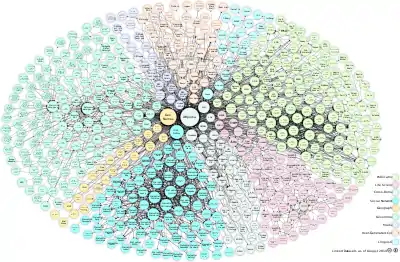UMBEL
UMBEL (Upper Mapping and Binding Exchange Layer) is a logically organized knowledge graph of 34,000 concepts and entity types that can be used in information science for relating information from disparate sources to one another. It was retired at the end of 2019.[2] UMBEL was first released in July 2008. Version 1.00 was released in February 2011.[3] Its current release is version 1.50.[4]
| Developer(s) | Structured Dynamics |
|---|---|
| Initial release | 16 July 2008 |
| Stable release | UMBEL 1.50
/ 10 May 2016[1] |
| Written in | |
| Type |
|
| License | Creative Commons Attribution 3.0 |
| Website | umbel |
The grounding of this information occurs by common reference to the permanent URIs for the UMBEL concepts; the connections within the UMBEL upper ontology enable concepts from sources at different levels of abstraction or specificity to be logically related. Since UMBEL is an open-source extract of the OpenCyc knowledge base, it can also take advantage of the reasoning capabilities within Cyc.
UMBEL has two means to promote the semantic interoperability of information:.[5] It is:
- An ontology of about 35,000 reference concepts, designed to provide common mapping points for relating different ontologies or schema to one another, and
- A vocabulary for aiding that ontology mapping, including expressions of likelihood relationships distinct from exact identity or equivalence. This vocabulary is also designed for interoperable domain ontologies.

UMBEL is written in the Semantic Web languages of SKOS and OWL 2. It is a class structure used in Linked Data, along with OpenCyc, YAGO, and the DBpedia ontology. Besides data integration, UMBEL has been used to aid concept search,[6][7] concept definitions,[8] query ranking,[9] ontology integration,[10] and ontology consistency checking.[11] It has also been used to build large ontologies [12] and for online question answering systems.[13]
Including OpenCyc, UMBEL has about 65,000 formal mappings to DBpedia, PROTON, GeoNames, and schema.org, and provides linkages to more than 2 million Wikipedia pages (English version). All of its reference concepts and mappings are organized under a hierarchy of 31 different "super types",[14] which are mostly disjoint from one another. Each of these "super types" has its own typology of entity classes to provide flexible tie-ins for external content. 90% of UMBEL is contained in these entity classes.
Notes
- "New, Major Upgrade of UMBEL Released: version 1.50". UMBEL Web site. 11 May 2016.
- Bergman, Michael K. (7 May 2019). "UMBEL to Be Retired by End of 2019". AI3:::Adaptive Information.
- See the release announcement.
- See http://umbel.org/resources/news/new-major-upgrade-of-umbel-released-version-1.50/
- "UMBEL (Upper Mapping and Binding Exchange Layer)". UMBEL Web Site. Retrieved 8 February 2016.
- Sah, M; Wade, V (2012). "A novel concept-based search for the web of data using UMBEL and a fuzzy retrieval model". The Semantic Web: Research and Applications. Berlin Heidelberg: Springer (published 27 May 2012). pp. 103–118.
- Sah, M; Wade, V (2013). "Personalized concept-based search and exploration on the web of data using results categorization" (PDF). The Semantic Web: Semantics and Big Data. Berlin Heidelberg: Springer (published 26 May 2013). pp. 532–547.
- Ballatore, Andrea (2016). "Prolegomena for an Ontology of Place" (PDF). In Onsrud, Harlan; Kuhn, Werner (eds.). Advancing Geographic Information Systems. Needham, MA: GSDI Association Press. pp. 91–103.
- Stecher, R; Costache, S; Niederée, C; Nejdl, W (7 June 2010). Query ranking in information integration. Advanced Information Systems Engineering. Notes on Numerical Fluid Mechanics and Multidisciplinary Design. 141. Springer Berlin Heidelberg. pp. 230–235. doi:10.1007/978-3-642-13094-6_19. ISBN 978-3-319-98176-5.
- Damova, M; et, al. (2012). "Creation and Integration of Reference Ontologies for Efficient LOD Management". In Pazienza, Maria Teresa (ed.). Semi-Automatic Ontology Development: Processes and Resources. IGI Global. pp. 162–199. ISBN 9781466601888.
- Sheng, Z; Wang, X; Shi, H; Feng, Z (26 October 2012). Checking and handling inconsistency of DBpedia. Web Information Systems and Mining. Lecture Notes in Computer Science. 7529. Springer Berlin Heidelberg. pp. 480–488. doi:10.1007/978-3-642-33469-6_60. ISBN 978-3-642-33468-9.
- Yablonsky, S (June 2009). "Semantic Web framework for development of very large ontologies" (PDF). Polibits. 39 (39): 19–26. CiteSeerX 10.1.1.186.4474. doi:10.17562/PB-39-3.
- Bishop, B; et, al. (January 2011). "Factforge: A fast track to the web of data" (PDF). Semantic Web. 2 (2): 157–166. doi:10.3233/SW-2011-0040.
- See Annex G in the UMBEL specifications.
External links
- Main page for UMBEL
- UMBEL specification, and its accompanying Annexes A - L, Z